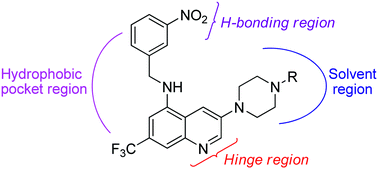Further SAR studies on 3,5-diamino-7-trifluoromethylquinolines as highly potent tyrosine kinase c-Met inhibitors: efforts to correct hERG inhibition
Abstract
A preclinical study on our previously discovered highly potent c-Met

* Corresponding authors
a
Synthetic Organic & Medicinal Chemistry Laboratory, Shanghai Institute of Materia Medica, Chinese Academy of Sciences, Shanghai 201203, China
E-mail:
aozhang@mail.shcnc.ac.cn
Fax: +86-21-50806035
Tel: +86-21-50806035
b
Division of Anti-Tumor Pharmacology, State Key Laboratory of Drug Research, Shanghai Institute of Materia Medica, Chinese Academy of Sciences, Shanghai 201203, China
E-mail:
mygeng@mail.shcnc.ac.cn, zb.gao@mail.shcnc.ac.cn
Fax: +86-21-50806072
Tel: +86-21-50806072
A preclinical study on our previously discovered highly potent c-Met

 Please wait while we load your content...
Something went wrong. Try again?
Please wait while we load your content...
Something went wrong. Try again?
Y. Wang, J. Ai, J. Yue, X. Peng, Y. Ji, A. Zhao, X. Gao, Y. Wang, Y. Chen, G. Liu, Z. Gao, M. Geng and A. Zhang, Med. Chem. Commun., 2012, 3, 1423 DOI: 10.1039/C2MD20192E
To request permission to reproduce material from this article, please go to the Copyright Clearance Center request page.
If you are an author contributing to an RSC publication, you do not need to request permission provided correct acknowledgement is given.
If you are the author of this article, you do not need to request permission to reproduce figures and diagrams provided correct acknowledgement is given. If you want to reproduce the whole article in a third-party publication (excluding your thesis/dissertation for which permission is not required) please go to the Copyright Clearance Center request page.
Read more about how to correctly acknowledge RSC content.
 Fetching data from CrossRef.
Fetching data from CrossRef.
This may take some time to load.
Loading related content
